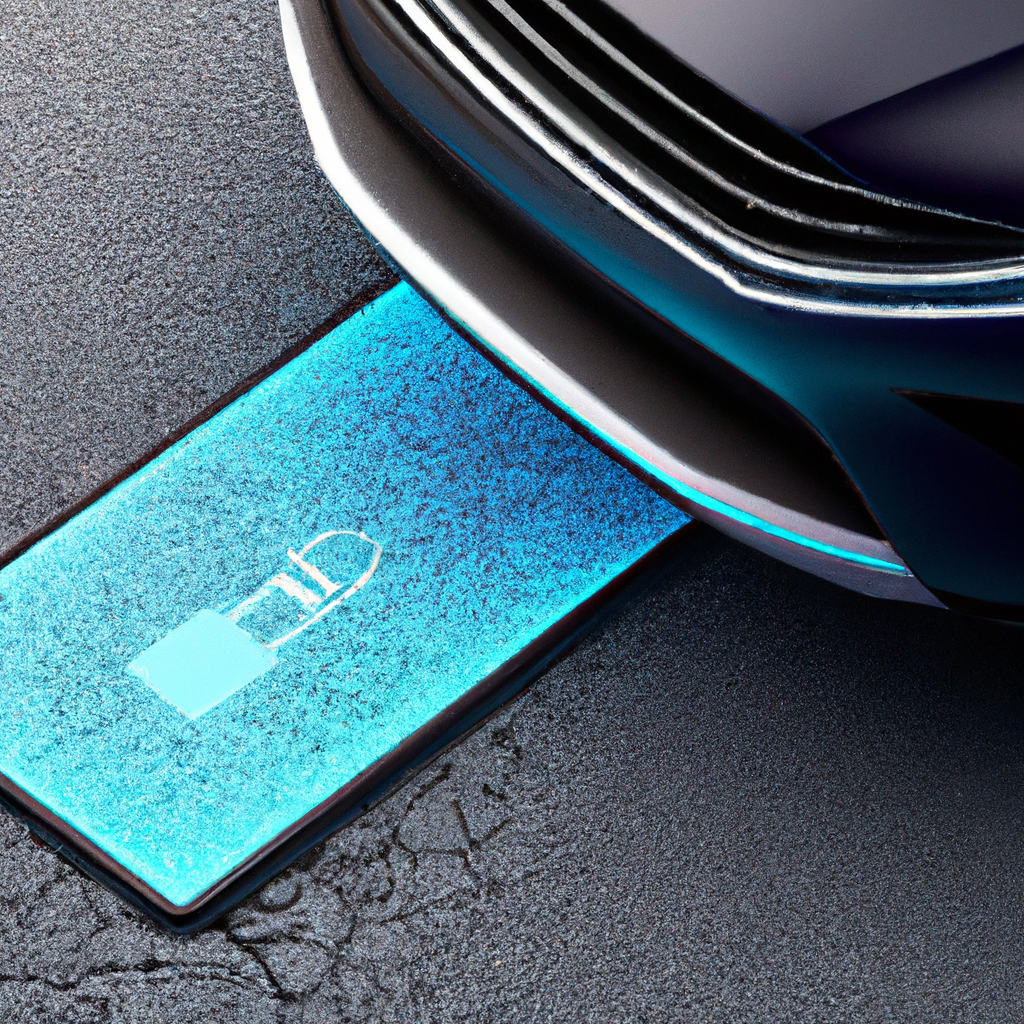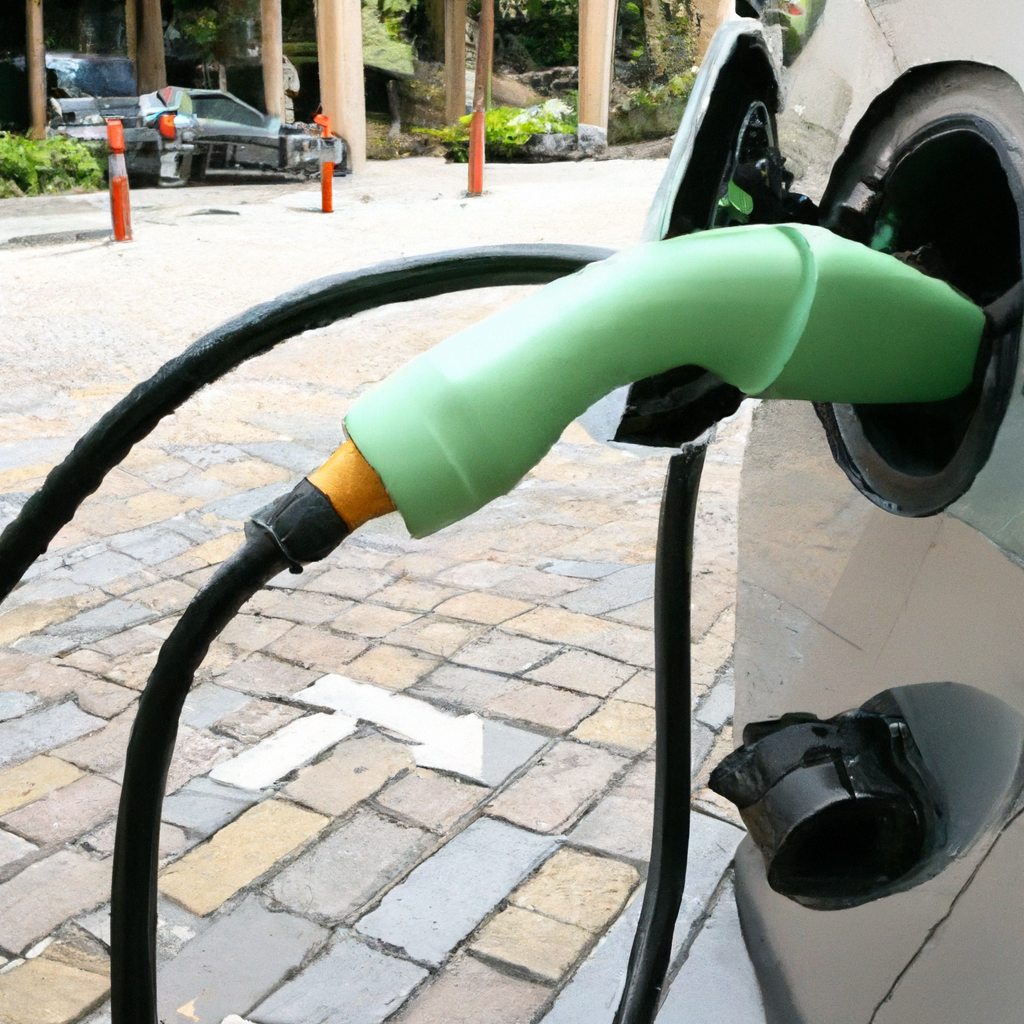
Imagine a world where charging your electric vehicle is as effortless as parking it. No more hassle of plugging in cables or searching for charging stations. Wireless EV charging is revolutionizing the way we power our cars, offering a convenient and seamless solution for the electric vehicle industry. With the ability to charge your car simply by parking it over a charging pad, this technology is paving the way towards a future of unparalleled convenience. In this article, we will explore the exciting advancements in wireless EV charging, its benefits, and the potential impact it will have on our daily lives. Get ready to imagine a world where charging your EV is not just easy, but truly effortless.
The Benefits of Wireless EV Charging
1.1 Increased Convenience
Wireless EV charging offers a range of benefits, but perhaps the most significant advantage is the increased convenience it provides. With wireless charging, you no longer have to worry about plugging in your electric vehicle (EV) every time you park it. Instead, charging can occur automatically when your vehicle is parked over a wireless charging pad or within range of a wireless charging station. This means no more hassle of untangling cords or searching for charging ports. Simply park your vehicle and let the wireless charging system take care of the rest.
1.2 Reduced Maintenance
Another benefit of wireless EV charging is reduced maintenance. Traditional charging methods often involve physical contact between the charging cable and the EV, leading to wear and tear over time. This can result in damaged cables or connectors that require costly repairs or replacements. With wireless charging, there is no physical connection necessary, eliminating the need for regular maintenance and reducing the likelihood of mechanical failure. This not only saves you money on maintenance costs but also ensures that your charging system remains reliable and efficient.
1.3 Enhanced Safety
Wireless EV charging systems are designed with safety in mind. Unlike traditional charging methods, which require direct contact between the charging cable and the vehicle, wireless charging eliminates the risk of electrical shock. With no exposed conductive parts, there is no need to worry about accidental contact with live wires. Additionally, wireless charging systems incorporate various safety features such as thermal and voltage monitoring to prevent overheating and ensure safe and efficient charging. Ultimately, wireless EV charging provides a safer and more reliable charging experience for EV owners.
1.4 Maximizing Energy Efficiency
Wireless EV charging systems are not only convenient and safe but also highly efficient. Through advanced technology, wireless charging systems can minimize energy losses during the charging process. Traditional charging methods often experience energy losses due to resistance in the charging cable, resulting in wasted electricity and slower charging times. However, with wireless charging, energy is transferred through magnetic fields, which allows for efficient power transfer. This enables faster and more efficient charging, maximizing the utilization of electricity and reducing energy waste.
How Wireless EV Charging Works
2.1 Inductive Charging System
Wireless EV charging operates on the principle of inductive charging, which is based on the transfer of energy through magnetic fields. The charging system consists of two main components: a charging pad or ground-mounted coil, and a receiver coil in the EV. When the EV is parked over the charging pad, an alternating current is passed through the pad, generating a magnetic field. This magnetic field induces an alternating current in the receiver coil, which is then converted into direct current to charge the EV’s battery.

This image is property of images.unsplash.com.
2.2 Resonant Inductive Coupling
Resonant inductive coupling is another key technology used in wireless EV charging. It allows for efficient power transfer between the charging pad and the receiver coil by matching the resonant frequencies of both components. By creating resonance, the charging system can transfer energy wirelessly over longer distances and with minimal energy losses. This technology ensures that the charging process is fast, efficient, and reliable, providing a seamless charging experience for EV owners.
2.3 Magnetic Fields and Power Transfer
Wireless EV charging relies on the transfer of energy through magnetic fields. When the charging pad generates a magnetic field, it creates an oscillating magnetic flux around the receiver coil in the EV. This changing magnetic field induces an alternating current in the receiver coil through electromagnetic induction. The alternating current is then rectified and converted into direct current to charge the EV’s battery. This power transfer occurs without any physical contact between the charging pad and the EV, making it a safe and convenient charging method.
2.4 Communication and Control Systems
To ensure the seamless operation of wireless EV charging, communication and control systems play a vital role. These systems allow for efficient power transfer, monitor the charging process, and ensure the compatibility between the charging pad and the EV. Through a combination of software and hardware, the control system regulates the power flow, monitors the charging status, and facilitates communication between the EV and the charging infrastructure. This enables intelligent charging management, optimizing the charging process and ensuring the longevity of the EV’s battery.
Advancements in Wireless EV Charging
3.1 Higher Power Transfer Rates
One of the significant advancements in wireless EV charging is the development of higher power transfer rates. Early wireless charging systems had limited power capabilities, resulting in slower charging times compared to traditional wired chargers. However, with advancements in technology, modern wireless charging systems can now support higher power transfer rates. This allows for faster charging, reducing the time required to replenish the EV’s battery and increasing the overall convenience of wireless charging.
3.2 Extended Charging Range
Another important development in wireless EV charging is the extension of charging range. Early wireless charging systems required close proximity between the charging pad and the receiver coil for efficient power transfer. However, recent advancements have enabled wireless charging over longer distances, providing greater flexibility in charging station placement. This allows for more convenient charging options, such as parking your EV over a charging pad embedded in the ground, without the need for precise alignment.

This image is property of images.unsplash.com.
3.3 Integration with Smart Grids
Wireless EV charging has the potential to integrate seamlessly with smart grids, enabling a more efficient and sustainable charging infrastructure. By connecting wireless charging stations to the grid, they can communicate and exchange information with the power network. This enables the charging infrastructure to respond to fluctuations in electricity supply and demand, optimizing the charging process and maximizing the utilization of renewable energy sources. Additionally, integration with smart grids allows for dynamic pricing schemes, incentivizing EV owners to charge their vehicles during off-peak hours, reducing strain on the grid, and promoting energy efficiency.
3.4 Autonomous Charging Infrastructure
The development of autonomous charging infrastructure is another significant advancement in wireless EV charging. With autonomous charging, EVs can identify and navigate to available charging stations on their own. This eliminates the need for human intervention during the charging process, making it even more convenient for EV owners. Autonomous charging infrastructure can be integrated into parking lots, garages, or even public roads, ensuring that EVs have access to charging facilities wherever they are. This advancement plays a crucial role in promoting the widespread adoption of EVs by enhancing the overall user experience.
Implementing Wireless EV Charging Infrastructure
4.1 Public Charging Stations
Implementing wireless EV charging infrastructure in public areas, such as parking lots, malls, or city centers, is vital for the widespread adoption of electric vehicles. Public charging stations provide convenient charging options for EV owners who may not have access to charging facilities at home or work. Wireless charging pads can be embedded in the ground, allowing for seamless integration into parking spaces. Additionally, strategically locating wireless charging stations in high-traffic areas ensures that EV owners can easily find and utilize the charging infrastructure.
4.2 Residential Charging Systems
Residential charging systems are crucial for individuals who own EVs and have access to off-street parking. Wireless EV charging offers an excellent solution for these homeowners, as it eliminates the need for installing and managing charging cables. With wireless charging, EV owners can simply park their vehicles over the charging pad in their driveway or garage, and the charging process begins automatically. This residential infrastructure allows for easy and hassle-free charging, ensuring that EV owners always have a fully charged vehicle ready to hit the road.
4.3 Workplace Charging Solutions
Workplace charging solutions play a significant role in supporting the adoption of electric vehicles by providing charging options for employees. Wireless charging in the workplace offers convenience and flexibility, allowing employees to charge their EVs during the workday. This eliminates concerns about EV range and the need to find charging stations during their daily commute. By offering wireless charging at workplaces, employers can support sustainable transportation and attract environmentally conscious employees who value the benefits of EV ownership.

This image is property of images.unsplash.com.
4.4 On-the-Road Charging Options
Wireless EV charging can also be implemented to provide on-the-road charging options for long-distance travel. Integrating wireless charging infrastructure along highways or in rest areas allows EV owners to charge their vehicles during road trips without requiring lengthy stops at traditional charging stations. This eliminates range anxiety and provides a seamless charging experience for EV owners. With on-the-road charging options, electric vehicles become a viable choice for long-distance travel, encouraging more people to switch to electric transportation.
Challenges and Limitations of Wireless EV Charging
5.1 Initial Cost and Infrastructure Investment
One of the main challenges of wireless EV charging is the initial cost and infrastructure investment required. Implementing wireless charging infrastructure involves the installation of charging pads or ground-mounted coils, which can be expensive, especially for widespread deployment. Additionally, upgrading existing parking facilities or road infrastructure to support wireless charging adds to the overall cost. However, as the technology matures and economies of scale come into play, the cost of wireless EV charging infrastructure is expected to decrease, making it more accessible to a broader range of stakeholders.
5.2 Efficiency and Energy Loss
Efficiency and energy loss are also important considerations when it comes to wireless EV charging. While wireless charging systems have improved significantly in terms of power transfer efficiency, there is still some energy loss during the charging process. This can be attributed to factors such as heat generation and resistance in the charging system components. Efforts are being made to enhance the efficiency of wireless charging systems to minimize energy loss and improve overall charging performance. As technology advances, wireless charging efficiency is expected to improve further, making it more comparable to traditional wired charging methods.
5.3 Standardization and Compatibility
Standardization and compatibility between different wireless charging systems pose a challenge to widespread adoption. Currently, there are multiple wireless charging technologies and standards available, which may not be interoperable with each other. This can create confusion and limit the options for EV owners when it comes to choosing a compatible charging system. Efforts are being made by industry organizations and regulatory bodies to establish common standards and protocols to ensure interoperability and compatibility among different wireless charging systems. Standardization will play a crucial role in simplifying the charging infrastructure and facilitating mass adoption of wireless EV charging.
5.4 Weather Conditions and Environmental Factors
Weather conditions and environmental factors can also impact the performance of wireless EV charging systems. Extreme temperatures, rain, snow, or other environmental elements can affect the charging efficiency and reliability of wireless charging systems. For example, in snowy conditions, the presence of snow on the charging pad or the vehicle’s undercarriage can interfere with power transfer. However, advancements in wireless charging technology are addressing these challenges, with solutions such as heated charging pads or sensors that detect and adjust to environmental conditions. These developments ensure that wireless charging systems remain functional and reliable regardless of weather or environmental factors.
Wireless EV Charging vs. Traditional Charging

6.1 Convenience and User Experience
When comparing wireless EV charging with traditional charging methods, convenience and user experience are significant differentiators. Wireless charging eliminates the need for manually connecting and disconnecting charging cables, making the process effortless and seamless. Unlike traditional charging, where positioning the charging cable correctly can be time-consuming and cumbersome, wireless charging allows for automatic charging when the vehicle is parked in the designated area. This hands-free approach enhances the overall user experience and simplifies the charging process for EV owners.
6.2 Safety and Durability
Wireless EV charging offers enhanced safety and durability compared to traditional charging methods. With no physical connection required, there is no risk of electrical shock or damage to charging cables or connectors. Additionally, wireless charging systems incorporate various safety features, such as thermal and voltage monitoring, to prevent overheating and ensure safe and efficient charging. These safety measures, coupled with the absence of physical wear and tear, make wireless charging systems more durable and reliable, providing peace of mind to EV owners.
6.3 Cost-effectiveness and Long-term Savings
In terms of cost-effectiveness and long-term savings, wireless EV charging can be a more economical option. While the initial cost of implementing wireless charging infrastructure may be higher, it eliminates the need for costly maintenance and repairs associated with traditional charging methods. The durability of wireless charging systems, coupled with the reduced wear and tear on components, ensures that the overall lifetime cost of ownership is lower compared to traditional charging. Additionally, wireless charging can be combined with smart grid integration and dynamic pricing schemes, allowing for optimized charging and potential cost savings in the long run.
6.4 Environmental Impact and Sustainability
From an environmental perspective, wireless EV charging contributes to sustainability and reduces the carbon footprint of electric transportation. By enabling autonomous charging infrastructure and integrating with smart grids, wireless charging optimizes the utilization of renewable energy sources. This not only reduces dependence on fossil fuels but also promotes the use of clean energy generated from renewable sources. Furthermore, wireless charging eliminates the need for manufacturing and disposing of charging cables, reducing waste and the environmental impact associated with cable production.
The Role of Wireless EV Charging in Mass Adoption of Electric Vehicles
7.1 Overcoming Range Anxiety
Range anxiety, the fear of running out of battery power while driving, has been a significant barrier to the mass adoption of electric vehicles. However, wireless EV charging plays a crucial role in overcoming this challenge by providing convenient and accessible charging options. By integrating wireless charging infrastructure in public and private locations, EV owners can easily charge their vehicles while going about their daily activities. This eliminates concerns about finding available charging stations and allows for a longer driving range without the fear of running out of power.

7.2 Streamlining Charging Processes
Wireless EV charging streamlines the charging process, making it more efficient and effortless for EV owners. With automatic charging initiation, EV owners do not have to spend time connecting and disconnecting charging cables. Instead, they can simply park their vehicles over a charging pad or within range of a wireless charging station and let the technology take care of the rest. This eliminates the need for EV owners to actively manage the charging process, saving time and effort. Streamlining the charging process encourages more people to adopt electric vehicles, leading to the mass adoption of sustainable transportation.
7.3 Accessibility and Availability
Wireless EV charging enhances the accessibility and availability of charging infrastructure, facilitating the mass adoption of electric vehicles. By implementing wireless charging systems in public areas, workplaces, and residential areas, EV owners have more opportunities to charge their vehicles conveniently. This increases the overall accessibility of charging infrastructure and reduces the reliance on traditional wired chargers. As wireless charging infrastructure becomes more widespread and readily available, more people can confidently switch to electric vehicles, knowing that charging options will be readily accessible.
7.4 Promoting Sustainable Transportation
The mass adoption of electric vehicles is essential for promoting sustainable transportation and reducing greenhouse gas emissions. Wireless EV charging plays a vital role in this transition by providing a convenient and user-friendly charging experience. By eliminating the barriers and inconveniences associated with traditional charging methods, wireless charging encourages more people to consider electric vehicles as a viable option. This increase in adoption further drives the demand for sustainable transportation options, leading to a widespread shift towards electric vehicles and reducing the environmental impact of transportation globally.
Leading Companies and Technologies in Wireless EV Charging
8.1 Qualcomm Halo
Qualcomm Halo is a leading technology company that specializes in wireless charging solutions for electric vehicles. Their advanced wireless charging systems are based on resonant inductive coupling, delivering efficient and reliable power transfer. Qualcomm Halo’s wireless charging technology is designed to integrate seamlessly with electric vehicles and is compatible with a wide range of EV models. With a focus on safety, convenience, and efficiency, Qualcomm Halo is at the forefront of wireless EV charging technology.
8.2 WiTricity
WiTricity is a renowned company in wireless power transfer technology, specializing in wireless charging solutions for electric vehicles. Their technology is based on magnetic resonance, enabling efficient and high-power transfer for various charging applications. WiTricity’s wireless charging systems offer flexibility and scalability, allowing for easy integration into different environments. With a commitment to innovation and sustainability, WiTricity is driving the development and adoption of wireless EV charging solutions.
8.3 Plugless
Plugless is a leading provider of wireless charging systems for electric vehicles. Their wireless charging technology is designed to be easy to use and compatible with a range of EV models. Plugless offers both residential and commercial wireless charging solutions, providing convenience and flexibility for EV owners. With a focus on user experience and reliable power transfer, Plugless is revolutionizing the way electric vehicles are charged.
8.4 Momentum Dynamics
Momentum Dynamics is a pioneering company in wireless charging technology for electric vehicles. Their wireless charging systems are designed for commercial and public transportation, including passenger cars, buses, and trucks. Momentum Dynamics’ technology enables efficient and high-power transfer, making it an ideal solution for fast-charging applications. With a focus on cutting-edge technology and sustainable transportation, Momentum Dynamics is shaping the future of wireless EV charging.
Government Initiatives and Support for Wireless EV Charging
9.1 Funding and Grants
Governments around the world are recognizing the importance of wireless EV charging in promoting sustainable transportation and reducing greenhouse gas emissions. To support the development and deployment of wireless charging infrastructure, many governments offer funding and grants to technology companies and organizations working in this field. These financial incentives encourage innovation and investment in wireless EV charging, accelerating the widespread adoption of electric vehicles.
9.2 Building Codes and Regulations
To ensure the safe and efficient installation of wireless charging infrastructure, governments are implementing building codes and regulations. These codes and regulations outline the requirements and standards for the installation and operation of wireless charging systems. By establishing clear guidelines, governments aim to streamline the implementation process and ensure that wireless charging infrastructure meets the necessary safety and performance standards.
9.3 Collaborations and Partnerships
Government initiatives often involve collaborations and partnerships between various stakeholders in the EV industry. Governments work together with technology companies, utilities, and transportation authorities to develop and implement wireless charging infrastructure. These collaborations ensure that the charging infrastructure meets the needs of EV owners, aligns with existing transportation networks, and contributes to sustainable transportation goals.
9.4 Incentives for Adoption
In addition to funding and support for infrastructure development, governments also provide incentives for the adoption of electric vehicles and wireless charging technology. These incentives can include tax credits, rebates, or grants for EV purchases. By offering financial incentives, governments encourage individuals and businesses to switch to electric vehicles and invest in wireless charging infrastructure. These incentives play a significant role in driving the mass adoption of electric vehicles and wireless EV charging.
The Future Outlook and Potential of Wireless EV Charging
10.1 Wireless Charging for Other Vehicles
While wireless EV charging is gaining traction, the technology also holds potential for other types of vehicles. Wireless charging can be extended to electric bicycles, scooters, or even autonomous vehicles. By integrating wireless charging infrastructure into cities and urban areas, these vehicles can charge conveniently and seamlessly, supporting sustainable transportation options across a range of modes.
10.2 Integration with Smart Cities
The future of wireless EV charging lies in its integration with smart cities. By connecting wireless charging systems to the smart grid and other intelligent infrastructure, charging patterns can be optimized, and renewable energy sources can be utilized efficiently. Additionally, wireless charging can be part of a broader smart city ecosystem, where data from charging infrastructure is collected and analyzed to optimize traffic flow, urban planning, and overall energy management.
10.3 Impact on Energy Grids
The widespread adoption of electric vehicles and wireless charging will have a significant impact on energy grids. As the demand for electricity for charging EVs increases, energy grid operators will need to anticipate and manage this load. However, with the integration of smart grid technology and the ability to adjust charging patterns based on electricity demand and availability, wireless charging systems can help balance the load on the grid and ensure efficient and sustainable energy use.
10.4 Revolutionizing Urban Transportation
Wireless EV charging has the potential to revolutionize urban transportation by providing a sustainable and convenient charging infrastructure. With wireless charging stations strategically located throughout cities, EV owners can charge their vehicles seamlessly and without interrupting their daily activities. This encourages more people to adopt electric vehicles, leading to the reduction of greenhouse gas emissions and creating cleaner and quieter cities.
In conclusion, wireless EV charging offers numerous benefits, including increased convenience, reduced maintenance, enhanced safety, and maximized energy efficiency. Advances in wireless charging technology, including higher power transfer rates, extended charging range, integration with smart grids, and autonomous charging infrastructure, are driving the mass adoption of electric vehicles. Implementing wireless charging infrastructure in public areas, residential spaces, workplaces, and on the road further supports the widespread adoption of electric vehicles. Despite challenges such as initial costs, efficiency and energy loss, standardization, and weather conditions, wireless EV charging provides a superior user experience compared to traditional charging methods. It plays a vital role in overcoming range anxiety, streamlining charging processes, enhancing accessibility, and promoting sustainable transportation. Leading companies such as Qualcomm Halo, WiTricity, Plugless, and Momentum Dynamics are at the forefront of wireless EV charging technology. Government initiatives and support, including funding, building codes, collaborations, and incentives, further drive the adoption of wireless charging. The future outlook for wireless EV charging is promising, with potential applications for other vehicles, integration with smart cities, impact on energy grids, and the revolutionization of urban transportation. With the continued development and implementation of wireless EV charging technology, the future of convenience in electric transportation is within reach.
RELATED POSTS
View all


